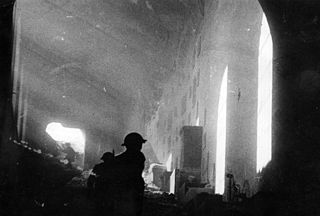
The Battle of Monte Cassino, also known as the Battle for Rome, was a series of four military assaults by the Allies against German forces in Italy during the Italian Campaign of World War II. The objective was to break through the Winter Line and facilitate an advance towards Rome.

The 2nd New Zealand Division, initially the New Zealand Division, was an infantry division of the New Zealand Military Forces during the Second World War. The division was commanded for most of its existence by Lieutenant-General Bernard C. Freyberg. It fought in Greece, Crete, the Western Desert and Italy. In the Western Desert Campaign, the division played a prominent role in the defeat of German and Italian forces in the Second Battle of El Alamein and the British Eighth Army's advance to Tunisia.

The Brazilian Expeditionary Force, nicknamed Cobras Fumantes, was a military division of the Brazilian Army and Air Force that fought as part of Allied forces in the Mediterranean Theatre of World War II. It numbered around 25,900 men, including a full infantry division, liaison flight, and fighter squadron.

The Gothic Line was a German and Italian defensive line of the Italian Campaign of World War II. It formed Field Marshal Albert Kesselring's last major line of defence along the summits of the northern part of the Apennine Mountains during the fighting retreat of the German forces in Italy against the Allied Armies in Italy, commanded by General Sir Harold Alexander.

João Batista Mascarenhas de Morais was a Brazilian army officer and commander of the Brazilian Expeditionary Force in the Second World War. He was ranked Field Marshal and was the last active Brazilian marshal.
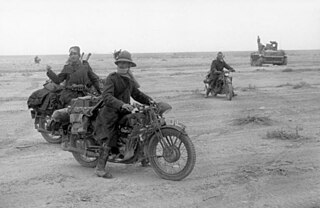
The 1st Army was a Royal Italian Army field army, in World War I, facing Austro-Hungarian and German forces, and in World War II, fighting on the North African front.

The 90th Light Infantry Division was a light infantry division of the German Army during World War II that served in North Africa as well as Sardinia and Italy. The division played a major role in most of the actions against the British Eighth Army in the Western Desert Campaign and eventually surrendered to the Allies in the final stages of the Tunisia Campaign in May 1943. It was re-constituted later in 1943 and deployed to Sardinia and when the expected Allied invasion of Sardinia failed to materialise, the division was moved to Italy. It was engaged in actions against the Allies in Italy from 1943 to April 1945 when the division was listed as "destroyed" in the Po River valley.

The 44th Infantry Division was formed on 1 April 1938 in Vienna, about two weeks after the Anschluss of Austria. It first saw combat at the start of the war in the Invasion of Poland, and also took part in the Battle of France in 1940. After a 9-month period of coastal defence the division was transferred East. On 22 June 1941, the division took part in the invasion of the Soviet Union, attached to Army Group South. It remained in the east after the failure of "Operation Barbarossa", taking part in defensive actions for the winter against the Soviet Army offensives near Izum and Kharkov. Refurbished, the division participated in the German summer offensive, and was subsequently destroyed with the 6th Army at Stalingrad in January 1943.

The Battle of Troina was an important battle that took place between 31 July and 6 August 1943, as part of the Allied invasion of Sicily during World War II. Forces of the U.S. II Corps, part of the U.S. Seventh Army, under George S. Patton, engaged in fierce fighting around the town of Troina in the central portion of Sicily along the Caronie Mountains. The battle focused around the numerous hills and mountains surrounding Troina which the Germans had heavily fortified and used as bases for direct and indirect fire.

The German 148th Reserve Division was a German reserve infantry formation during the Second World War. It was made up of three infantry regiments and an artillery regiment. Initially an occupation force in southern France, serving as a depot for rest and rifitting, it was activated as an infantry division and fought in Italy from 1944 to 1945. Redesignated the 148th Infantry Division in September 1944 to fight the allied invasion during Operation Dragoon, it later fought in the Po River battles, surrendering to the Brazilian Expeditionary Force on April 28, 1945, after being encircled in the Battle of Collecchio, near the city of Fornovo di Taro at Galano.

The French Expeditionary Corps, also known as the French Expeditionary Corps in Italy, was an expeditionary force of the French Liberation Army. Created in 1943, the corps fought in the Italian Campaign of World War II, under the command of General Alphonse Juin. Consisting of 112,000 men divided into four divisions, all but one of the divisions were colonial units, mostly Moroccans and Algerians drawn from the Army of Africa and led by French officers. Overall the Expeditionary Corps was composed of approximately 60 % of colonial troops.
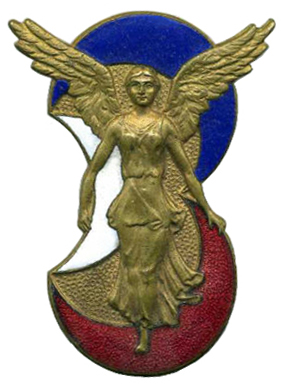
The 3rd Algerian Infantry Division was an infantry division of the Army of Africa which participated in World War II.

The United States Army North (ARNORTH) is a formation of the United States Army. An Army Service Component Command (ASCC) subordinate to United States Northern Command (NORTHCOM), ARNORTH is the joint force land component of NORTHCOM. ARNORTH is responsible for homeland defense and defense support of civil authorities. ARNORTH is headquartered at Fort Sam Houston, Texas. Redesignated ARNORTH in 2004, it was first activated in early January 1943 as the United States Fifth Army, under the command of Lieutenant General Mark W. Clark.

The Battle of Estero Bellaco was one of the bloodiest battles of the Paraguayan War. The battle was fought on 2 May 1866 with the Paraguayan Army suffering 2,000 casualties among the dead and wounded. Likewise, 300 of their men were taken prisoner by the troops belonging to the Triple Alliance: Argentina, Brazil and Uruguay. The allies lost nearly 2,000 men, mostly wounded, and the Uruguayan troops of General Venancio Flores - commanded by León de Pallejas - were severely decimated, accounting for the vast majority of allied deaths.

The 10th Mountain Division Headquarters and Headquarters Battalion is a unit of the United States Army headquartered at Fort Drum, New York. It is the organization for the command elements of the 10th Mountain Division. The battalion contains the division's senior command structure, including its headquarters company, as well as communications, intelligence, operational and support elements as well as the Division Band which provide services to any units assigned to the headquarters at a time.

The Battle of Garfagnana, known to the Germans as Operation Winter Storm and nicknamed the "Christmas Offensive", was a successful Axis offensive against American forces on the western sector of the Gothic Line during World War II. It took place in December 1944 in the north Tuscan Apennines, near Massa and Lucca.
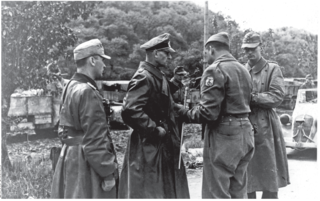
The Battle of Collecchio-Fornovo was a battle of the Second World War between the Brazilian Expeditionary Force, along with Italian partisans and units from the American 1st Armored and 92nd Infantry Divisions, against the Wehrmacht's 148th Infantry Division, 90th Panzergrenadier Divisions and the fascist National Republican Army's 1st Bersaglieri "Italia" and the 4th Alpini "Monte Rosa" Divisions. The battle was fought around the town of Fornovo di Taro, about 8 miles (13 km) to the southwest of Parma, Italy. The Allies defeated the Axis forces, which were attempting to break through to the north.

15th Panzergrenadier Division was a mobile division of the German Army in World War II.
The 232nd Rifle Division was an infantry division of the Red Army, originally formed in the weeks just before the start of the German invasion, based on the shtat of September 13, 1939. It was quickly moved to the fighting front as part of the 66th Rifle Corps in 21st Army, and it remained in this Corps for its brief existence. 21st Army was deployed in western Belarus, attempting to plug the gaps created by the defeats of the border armies in the first weeks of Barbarossa, and the division made a deep penetration into the German rear in the eastern fringes of the Pripet Marshes, but this was ultimately unsustainable. By early September, the 232nd was greatly depleted due to almost continual combat, before being encircled and destroyed east of Kyiv.
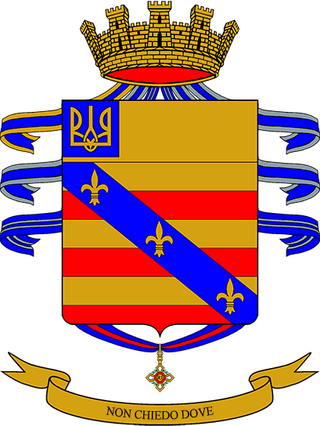
The 89th Infantry Regiment "Salerno" is an inactive unit of the Italian Army last based in Salerno. The regiment is named for the city of Salerno and part of the Italian Army's infantry arm.


















